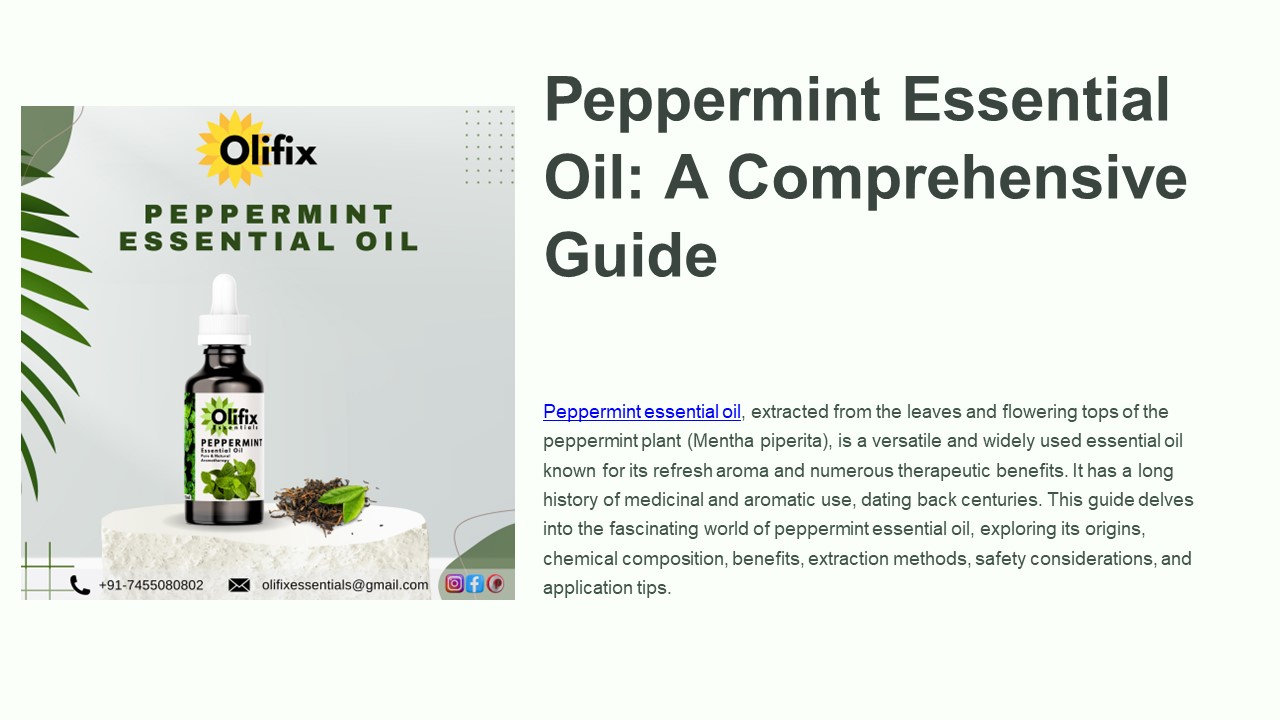Peppermint Essential Oil: A Comprehensive Guide (1) PowerPoint PPT Presentation
Title: Peppermint Essential Oil: A Comprehensive Guide (1)
1
Peppermint Essential Oil A Comprehensive Guide
Peppermint essential oil, extracted from the
leaves and flowering tops of the peppermint plant
(Mentha piperita), is a versatile and widely used
essential oil known for its refresh aroma and
numerous therapeutic benefits. It has a long
history of medicinal and aromatic use, dating
back centuries. This guide delves into the
fascinating world of peppermint essential oil,
exploring its origins, chemical composition,
benefits, extraction methods, safety
considerations, and application tips.
2
Origins and History
Ancient Times
1
The use of peppermint dates back to ancient
Egypt, where it was valued for its medicinal
properties. Peppermint was also cultivated in
ancient Greece and Rome, where it was used for a
variety of purposes, including culinary,
medicinal, and religious.
Medieval Era
2
During the Middle Ages, peppermint was widely
used throughout Europe for its medicinal and
aromatic properties. It was used to treat
digestive ailments, headaches, and respiratory
problems. The oil was also used to flavor foods
and beverages.
Modern Times
3
In modern times, peppermint oil remains a popular
essential oil used for its various therapeutic
properties. It is widely used in aromatherapy,
medicine, and personal care products.
3
Chemical Composition
Menthol
Menthone
1
2
Menthol is the primary active constituent of
peppermint essential oil, accounting for up to
40-50 of its composition. It is responsible for
the oil's characteristic cooling and refreshing
sensation.
Menthone is another significant compound present
in peppermint oil. It contributes to the oil's
refreshing aroma and possesses antibacterial and
anti-inflammatory properties.
Other Compounds
Synergistic Effects
3
4
In addition to menthol and menthone, peppermint
oil contains other minor compounds, including
menthyl acetate, menthyl propionate, and
isomenthone. These compounds contribute to the
oil's overall aroma and therapeutic effects.
The various compounds present in peppermint oil
work to create its unique therapeutic profile.
This means that the combined effects of these
compounds are greater than the sum of their
individual effects.
4
Benefits and Uses
Aromatherapy
Other Uses
Peppermint oil is widely used in aromatherapy for
its refreshing aroma. It can help to improve
mood, reduce stress, and promote relaxation. It
can also be used to clear the mind and improve
concentration.
Peppermint oil is also used in a variety of other
applications, including oral hygiene products,
digestive aids, and personal care products. It
can also be added to bathwater for a refreshing
and pleasant experience.
Topical Application
When diluted in a carrier oil, peppermint oil can
be applied topically to relieve muscle aches,
headaches, and skin irritations. It can also be
used as a natural insect repellent.
5
Extraction Methods
Steam Distillation
Solvent Extraction
Steam distillation is the most common method used
to extract peppermint essential oil. This process
involves passing steam through a vessel
containing crushed peppermint leaves. The steam
carries the volatile oil molecules, which are
then condensed and collected.
Solvent extraction involves using a solvent to
dissolve the essential oil from the plant
material. This method is not typically used for
peppermint oil extraction due to concerns about
the potential presence of solvent residues in the
final product.
Cold Pressing
Cold pressing, also known as expression, is a
method used to extract essential oils from citrus
fruits. It involves pressing the fruit's rind to
release the oil. This method is not commonly used
for peppermint oil extraction.
6
Dilution and Application
Application
Dilution Ratio
Topical (Skin)
1-2 (1-2 drops per 1 ounce of carrier oil)
Aromatherapy
Add 3-5 drops to a diffuser or bathwater

